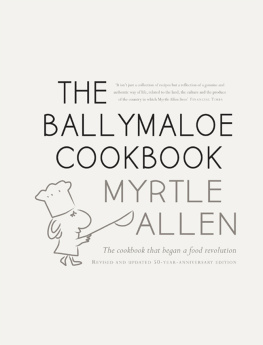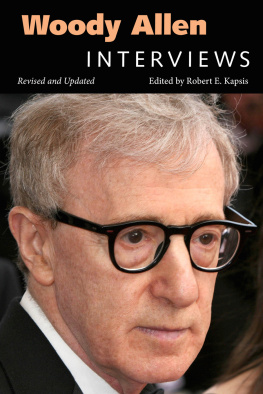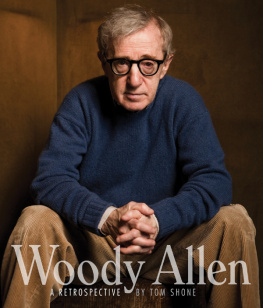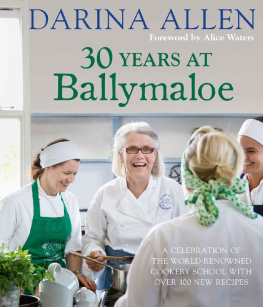THE
BALLYMALOE
COOKBOOK
MYRTLE ALLEN
Foreword in Tributes by DARINA ALLEN, YOTAM OTTOLENGHI,
ROSS LEWIS and GEORGINA CAMPBELL
Introduction by LEN DEIGHTON
GILL & MACMILLAN
Contents
Foreword in Tributes
Darina Allen, chef, author, television presenter and founder of the Ballymaloe Cookery School
How fortunate am I that our paths crossed in life. I first met Myrtle Allen on 16 June 1968, when I arrived down to Ballymaloe House in East Cork fresh from Cathal Brugha Street Hotel School in Dublin. I was so excited about my first job. I had heard about this farmers wife who had opened a restaurant in her large rambling country house in the middle of a farm in East Cork, miles from the city. Apparently she wrote the menu every day depending on what seasonal food was available on the farm and what fresh fish came in from the boats in Ballycotton. This was unheard of at that time, when most restaurants wrote the menu the day they opened and it was the same ten years later.
From the very first day I was intrigued by Myrtle and her philosophy. She had a deep appreciation and understanding of the quality of Irish produce at a time when many still had an inferiority complex and felt that what was available in the UK or France had to be more exciting than what we had in Ireland. It was a joy to be in the kitchen with her; I was totally inspired. She taught me the opposite of much of what I had learned at hotel school but reinforced my mothers values of fresh, naturally produced local food in season cooked and served simply, but beautifully.
The much-loved Ballymaloe Cookbook remains an important cultural and culinary milestone in the history of Irish food. Thirty-seven years later, it is astonishing how the book, which has never been out of print, still appears current, fresh and accessible.
Yotam Ottolenghi, chef, author and restaurant owner
Its so hard not to fall back on the clichs when thinking about Myrtle Allen: the farmers wife whose pioneering spirit changed the face of Irish cuisine; the matriarch who championed locally sourced, seasonal, sustainably harvested produce at a time when such things were unheard of, let alone mainstream; someone who was handwriting daily changing menus before the world of trendy restaurants caught up. My memories of Myrtle Allens Ballymaloe serve only to reinforce the clichs, Im afraid: walled gardens and edible flowers, soda bread and best-butter heaven, chicken liver pt and wild garlic soup, scones and elderflower jam and lemon verbena tea, wandering-around chickens and seawater-fresh air. Staying at and dining in Myrtles hotel allows for that very rare moment when you pause for a minute, take it all in and, all of a sudden, everything seems very okay with the world.
Ross Lewis, Michelin star-winning chef and co-owner of Chapter One restaurant
One of my first memories of a grand dining experience as a child involved a tired Lewis family knocking on the door of Ballymaloe House in search of some repast. Although it was closed for renovation, Myrtle Allen insisted that these first-time guests would be accommodated, and fifteen minutes later we were sat in the grand dining room partaking in the family Sunday buffet surrounded by decorators, painters and scaffolding! It is this kind of anecdotal evidence that reaffirms Ballymaloe as the cradle of Irish hospitality.
Myrtle Allen has been the undisputed catalyst for our great Irish food movement. I have known her for twenty-four years as a founder member of Euro-toques International in Ireland. Its a further testament to her inspirational character that Euro-toques Ireland is one of the strongest arms of the organisation as a whole. It remains steadfast in following her dictate as an uncompromising voice and promoter of quality Irish food, and in particular the Irish artisan. Her drive to endorse their promotion is what makes Myrtle Allen the most influential person in Irish food and hospitality.
Georgina Campbell, food and hospitality writer, president of the Irish Food Writers Guild and founder of the Georgina Campbell Guides
It was love at first sight for me when arriving into the intensely restorative atmosphere of Ballymaloe on a dark, wet Friday night in 1970. Within minutes of arrival, every trace of travel weariness had lifted and, refreshed, we relished the strong simplicity of a carefully prepared dinner made with fresh local foods, notably produce from the farm. Ballymaloe still has that magical effect, and it can be sensed in The Ballymaloe Cookbook, where Myrtle Allens voice is very direct.
An unlikely food heroine, cooking may not have been her forte as a bride, but how fortunate for us all that she married Ivan Allen, who not only produced top quality food on the farm but whose deep knowledge of food and wine constantly spurred her on. As she put it simply in The Ballymaloe Cookbook acknowledgments, Nobody can cook well without somebody who will eat. The more discriminating the gourmet, the better the cook.
This classic book is far more than the collection of recipes used in the Yeats Room restaurant at Ballymaloe (wonderful as that is in itself). It is uniquely informative on many levels, telling us so much of its era and giving us a good grounding in food sourcing and practical cookery along the way.
Myrtle is a natural teacher, intuitively sharing her knowledge with humorous good sense (accompanied here by Mel Calmans amusing, multi-layered illustrations), practicality and the keen appreciation of producers for which she is famous. It could be said that she was ahead of her time, but Myrtle has always been in her time her voice today is steadfastly the same as it was when the original edition of The Ballymaloe Cookbook was published in 1977, and it is the rest of us who have been out of kilter.
Introduction to the New Edition of the Ballymaloe Cookbook
My mother would only allow us to eat vegetables out of our own garden. She was very health conscious. In her day, food was the thing that saved you from serious illness. If you ate well you were going to resist disease. Its quite interesting that the rules for bringing up a healthy family were much the same then as now. It was all very seasonal then, and we cooked in the same way as we still do in Ballymaloe.
My career began with a regular article in the Irish Farmers Journal. I was terribly careful not to make a mistake. I got books by all the best food writers. I looked up all of the different ways people made a certain dish and then went into the kitchen and cooked it. I then put them in the paper. By the time I had done that for a couple of years, I really knew a lot about cooking.
The idea of having a restaurant was attractive. In early May 1964, I put an advertisement in the Cork Examiner: Dine in a historic country house. Telephone number for reservations. I gave no clue as to where the house might be. I didnt want everybody knowing about it; I felt a bit self-conscious. But I wanted to serve really good food.
The wonderful thing was that we had this fantastic range of food, all absolutely fresh. We had a garden, so we had herbs and all the garden vegetables. We had our own eggs, pork and beef, and we had milk and cream coming up from the dairy. I wrote every menu by hand. I remember sitting in the little table by the window and writing out each one. At least it was a chance to sit down for half an hour!
Since I first opened the restaurant at Ballymaloe, peoples tastes have changed a lot, and theres no question that your average diner in Ireland is much more sophisticated now. I did very simple food, and still do in a way. I started the restaurant because I knew that the food that was available to me at Ballymaloe was terribly good as it was. I get enormous satisfaction in being able to give people the food that I think we ought to be eating.










